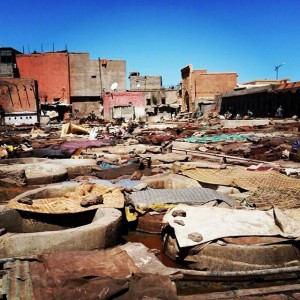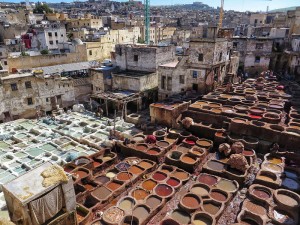The traditional process for tanning leather is undoubtedly smelly, yet this smell is a small price to pay for witnessing such a unique and interesting sight. Where else would you get the chance to see the men tread and rinse skins in mysterious liquids and dyes before scraping and stretching the hides using traditional techniques. Although it is possible to see the tanneries without a guide, it is a lot easier with. However, it is important to agree a price first and beware of excessive demands. Included in this fee you should also be gifted a sprig of mint to hold to your face to mask the smell.
We would like to give you a taste (thankfully, not a literal taste) of the traditional tanning process as witness here in the Marrakech Tanneries. Maybe, after our short guide, you will choose to witness the Marrakesh Tanneries for yourself; just don’t forget to ask for a sprig of mint!!
Step 1 – Iferd
The traditional process of tanning leather begins with soaking the skins in a fermented solution of pigeon poo and tannery waste, known as iferd. The skin ferments in this solution for 3 days in the summer and up to 6 days in the winter before they are squeezed out and left to dry. According to the folklore of the tanners, this first step of the tanning process is where the skin eats, drinks and sleeps before being ‘reborn’ from the water.
Step 2 – A long bath in a Lime and Argan-kernel solution
Once dry, excess hair is scraped off the skins before they go into a pit of lime and argan-kernel ash. This bathing process lasts 15-20 days in the summer and 30 days in the winter, working to remove any remaining flesh and hair to prepare the skin for tanning products. The argan-kernels in this solution are a by-product from Morocco’s thriving argan oil industry. The recycling of this otherwise waste product is a good example of how Marrakechi society functions as an interconnected unit, selflessly sharing and always willing to work together and cooperate.
Step 3 – Qasriya
After being washed, the skins spend 24 hours in a qasriya, a round pit of yet more pigeon poo and water. At this stage the skin becomes thinner and stretcher. The traditional tanning process of tanning leather is heavily laden with symbolism and mythology. Indeed, it is at this qasriya stage that the skin is said to receive naks, a spirit.
Step 4 – The Tanning process begins
It is finally after receiving the spirit of naks that the actual tanning process. The skins are scraped with pottery shards and beaten with alum, oil and water in preparation to receive the dye. Traditional tanners only ever use plants to dye their leather – that is, roots, bark, seeds and fruits; the ingredients needed to make the dying solution depends on the type of hide used – cow, camel, goat, sheep – and the color the leather will be dyed. For example, the infamous yellow babouche is traditionally made using pomegranates, who would have guessed that? The dye is applied by hand, as it has always been, before the skin is left to dry out in the hot Moroccan sun to dry once more.
Step 5 – A Smooth Finish
Finally, the skins are stretched between two ropes to make them smoother and more flexible. This traditional process is difficult work and is only carried out by the younger, more able-bodied men. This stage is said to give the skin a second life, as leather is reborn into handcrafted leather products such as bags, satchels, poofs, babouche slippers and more. All of these leather items will be available for sale further along the ‘Leather and Tanning’ Medina walk when you enter the world famous souks, so keep going to see what surprises Marrakech has to offer.

